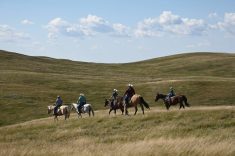An American investor, who’s also had a 47-year career in the beef packing industry has bought the long-closed Rancher’s Beef packing plant at Balzac, just north of Calgary with every intention of making it a profitable beef processing facility.
Rich Vesta of Fort Collins Colorado, who worked his way through the business from a meat cutter to a top executive of one of the largest meat-processing companies in the world, says after renovations and upgrades he plans to be processing cattle under the Harmony Beef name by early in 2014.
Read Also

Harvest wraps up and fall work begins
At the Eppich famly ranch in western Saskatchewan, the fall harvest was successful with few breakdowns, cows and calves have been sorted and a new tractor has arrived
“I’ve been in the meat business all my life — started as a meat cutter when I was 14,” says Vesta, former CEO of JBS North American beef division. “I’ve owned food retail, owned and managed packaging plants across the U.S. I know every aspect of this business and have always made money — sometimes I didn’t make a lot of money, but I always made money.
“I wasn’t ready to retire and when I found this gem of a facility here in Alberta I knew it could make money too. It is a state-of-the-art facility. I don’t want to sound flippant, but often raising the money for a project like this is the easy part. The challenge is to know how to manage and operate the facility and market your product.”
Joining Vesta in the management of the family-owned company is his son Jeremy, a risk-management specialist and former grain trader with Bunge, now learning the meat packing business.
NEW NAME, NEW TECHNOLOGY
Vesta says an $18-million retrofitting will be underway over the coming months — mostly to introduce new technology to the existing infrastructure, Vesta says Harmony Beef will be up and running by June 1, 2014, with about 125 workers processing up to 775 head of cattle per day.
The initial six to nine months of operation will simply concentrate on getting everyone trained and any kinks out of the system. Vesta says while he plans to supply any local markets he can, the main focus will be on a global marketplace with branded beef products, all produced in the largest EU-approved packing plant in Canada.
“I am not here to compete with the existing meat packing plants, because we won’t be producing commodity beef,” says Vesta, who now has a home in nearby Airdrie. “It took me a while to realize it myself, but Alberta and western Canadian ranchers produce some of the highest-quality beef in the world.
IN HINDSIGHT REALLY BAD TIMING
The original $40-million Rancher’s Beef plant, backed by 50 investors, was launched in 2005 as a producer-owned facility aimed at shoring up the Alberta beef industry in the wake of the 2003 BSE crisis. But burdened by debt, a period of high Canadian dollar, limited markets, high labour costs, regulatory issues and a number of other local challenges, the business began bleeding money almost immediately and closed 14 months later.
Rancher’s Beef president Rick Martinez said in a 2007 radio interview as the plant was shutting down, “If you threw a dart at the wall you couldn’t have picked a worse time to open a facility in the beef industry. The margins were at 10-year lows.”
The bankrupt plant and 140-acre site valued at $75 million was bought through a court-ordered sale by Alberta-based Sunterra Beef in late 2007 for an undisclosed amount, although it never did operate as a beef plant again.
Vesta’s company, Vesta Holdings, bought the facility from Sunterra for an undisclosed amount, with the sale to be finalized by Nov. 1, 2013.
Vesta says the name Harmony Beef has particular significance.
“That is our plan, to be here and operate in harmony with all aspects of the industry,” says Vesta. “With the technology we are incorporating in the plant we want to operate in harmony with the environment, and also be in harmony with our employees, our suppliers and our customers.” †















